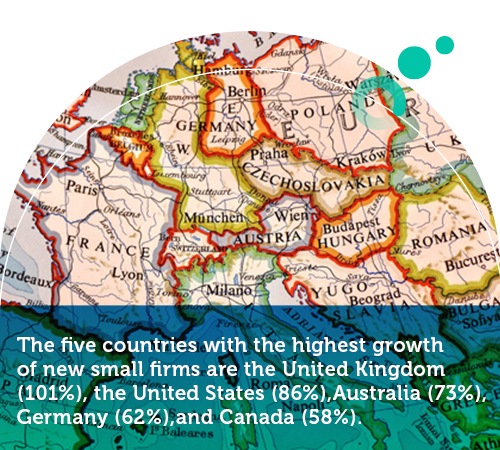
Considerations When Purchasing Webinar Software
As webinars grow in popularity and convenience, we look at the tools that make them possible. Learn how to choose webinar software that’s reliable, user-friendly, and has all the right features.

99.9% of all businesses in the U.S. are small businesses.
Hence, it’s no surprise that they are the backbone of the American economy. They drive the local economies, support their communities, and create a massive number of job opportunities. In fact, from 1995 to 2020, small companies in the U.S. generated 62% of new jobs.
A catch-all definition for a small business in the U.S. is one with fewer than 500 employees. However, the U.S. Small Business Association (SBA) has different defining standards for various industries. In the E.U., a small company has less than 50 employees, while, in Australia, it has under 20. Microbusinesses are small businesses that employ a few people.
Suppose you’re thinking about venturing into the small business world. In that case, the small business statistics below give helpful insight into developing a solid business strategy.
From freelancers to brick-and-mortar companies, food services, or auto repair shops, there are 32.5 million small firms in the U.S.
These small business stats show why they are essential for the economy, what challenges they face, and other important facts.

The pandemic had a negative impact on all businesses, but small ones suffered the most significant blow. During this time, small companies had to deal with many challenges – reducing the number of employees, surviving revenue loss, and closing. The following SMB statistics show that it was a setback for many small-sized enterprises.
However, this shouldn’t discourage entrepreneurs.
In fact, the small business statistics below show how resilient and adaptable small business owners are even when the economy is struggling.
When opening an enterprise, founders come across financial challenges they must overcome. For small businesses, the most significant challenges are access to funding and having consistent cash flow.
Another hardship, especially with the Great Resignation, is retaining employees. Therefore, developing a sound business strategy helps to face these challenges.


We are all aware that people spend a lot of their time browsing social media. Over 95% of people use social networks. In fact, people often interact with companies through them.
Therefore, small businesses can take advantage of social media and use it as a strategy. Why? Because owners can DIY the process at first, and it is a terrific way to hype a product or service.
With the appearance of the Facebook marketplace and the Instagram Shop tab, it is now easier to market what you are selling.
More than one billion monthly users in Q1 of 2021 used the Facebook marketplace, whereas Facebook shops reported one million monthly users.
90% of all Instagram users follow one or more businesses. 44% of all make a purchase on Instagram every week.
Using social networks to market the products and services of a small company is a great opportunity. However, it is important to create a good strategy to increase sales. Here are some tips that can help:
Small companies in the U.S. have been around since the 1600s. Back then, it all started with trading. Most colonialists owned land, and they used it to farm crops and produce clothing and soap. This is what they were trading. Thus began the development of small enterprises.
Later, in the 1800s, with the nation’s independence, the economy flourished, and the monetary system grew. Small businesses experienced a boom. They started offering a greater variety of products, and people wanted to buy them. Suddenly, many owners realized that creating a unique product gives more freedom and success, so millions of patents were filed.
Small companies faced their first and most significant challenge in the 1900s: corporate America. However, in the 1980s, big enterprises couldn’t hold their ground anymore because of foreign competition. This made way for small businesses to flourish and prosper. As a result, many people started showing interest in entrepreneurship, thus stabilizing small companies.

Since then, as we can see from the small business growth statistics, small enterprises have become a pillar of the American economy.
Small business statistics show that owners might experience many rises and falls.
In fact, they have not had a break since the start of COVID-19 in 2020. All the government’s lockdowns and measures in the last two years made it quite difficult for them to survive.
Moving forward, small business owners are faced with another challenge at the moment – the increase in gas prices. However, most of them try to take different steps to contain the damage. Some of them are trimming services, whereas others are revising contracts. Many of them decide to pass on the extra costs to their clients.
Browse our curated list of vendors to find the best solution for your needs.
Subscribe to our newsletter for the latest trends, expert tips, and workplace insights!

As webinars grow in popularity and convenience, we look at the tools that make them possible. Learn how to choose webinar software that’s reliable, user-friendly, and has all the right features.

Uncover 50+ key statistics on employee financial wellness, providing valuable insights into the financial state within the workplace.

Unravel the complexities and implications of FLSA status and its significance in employment law, ensuring fair compensation and compliance for employers and employees.

Discover the growing trend of consumers utilizing BNPL services to pay for purchases.
Used by most of the top employee benefits consultants in the US, Shortlister is where you can find, research and select HR and benefits vendors for your clients.
Shortlister helps you reach your ideal prospects. Claim your free account to control your message and receive employer, consultant and health plan leads.